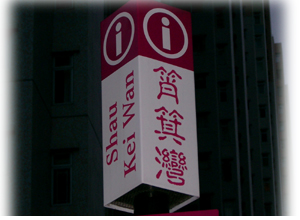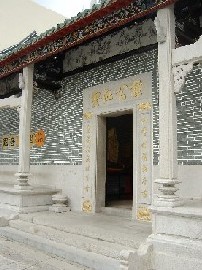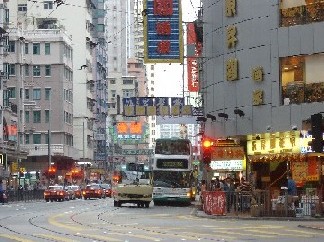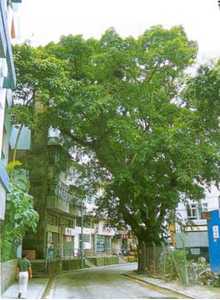Shau Kei Wan
|
|
Shau Kei Wan (筲箕灣) is a town in Eastern district, Hong Kong. Literally, Shau Kei means a pail, and Wan implies that the town is developed along the coast. Nowadays it is a relatively densely populated town compared with some developing areas.
History
Name
The name Shau Kei Wan comes from the bay where the town is located. The bay is so named because its shape looks like a Shau Kei (rice basket). The bay had another name in the past - Ngor Yan Wan (Harbour of Starving Men). It is said that there was a ship of people forced to dock by a typhoon. They landed hoping to buy some food and found that there was no agricultural products at all in the place. They left almost starving. The name of the bay is changed to Aldrich Bay. It is named after a British navy captain who worked there. Shau Kei Wan is now the name of the town, while Aldrich Bay is the name of the bay. On maps in 1950s, Buffalo Bay is also marked, together with Aldrich Bay.
There is another story behind the name of Shau Kei Wan, which could be translated into "Pail Bay" directly in Cantonese. It is said that in the late Southern Song Dynasty, a man named Cheung Chun met a fairy who gave him some treasures together with a pail. As he sailed back to Kowloon with the navy, the pail fell into sea, just off the coast of the area now known as Eastern District.
A sadder story tells of a boatwoman, Chu Tee, who was widowed soon after getting married. She gave birth to a son, Ah Ha, after her husband's death. Ah Ha was a good boy who tragically lost his sight after catching smallpox. When he was 15, his mother fell ill. To support the family, Ah Ha became a beggar, sitting on the waterfront every day with a pail, until one year he disappeared in a violent storm. Only his pail was ever found. Chu Yee missed her son so much that she went insane, but Ah Ha's filial deed was immortalised in the name of Shau Kei Wan.
Past Development
In the early 1700s, a foreign merchant ship took shelter at Shau Kei Wan from a storm. Since no inhabitants were there, the crew nicknamed this bay the "Starving Men's Bay".
In the middle of the 18th century, several families who lived by stone mining moved into this area. At that time, there were no houses on Shau Kei Wan's bank because the stonemasons usually lived in boats and their families lived in the mainland.
In the middle of the 19th century, more and more boats were berthed in Shau Kei Wan. Stonemasons began to build houses in stone mines. Pirates were around. At that time, the local population was only 1,200, roughly 5% of today's population. In 1860, to enable the police to seize pirates more efficiently, Governor Macdonnell dismantled some houses, opened up a street named Shau Kei Wan Main Street East near the seaside, set up wharfs and built stores and houses along the street.
By the early 1900s, the environment and public security in the area had been much improved and it attracted more people. Many fishermen also dwelt in Shau Kei Wan during non-fishcatching time.
After World War II, Shau Kei Wan gradually developed into an important fish-trading market.
By the 1960s, government decided to offer better living conditions to fishermen in Hong Kong. Therefore many multi-storey buildings were built in Shau Kei Wan. Estates had also been developed. And now, this area has become a densely populated residential district. It is said that the coast of Adrich Bay suffered a great change since the late 19th century.
SKWKHChan_boats_resized.jpg
Fishing boats
Photo courtesy Chan Kam Ho, HKUŠ, 2004
Fishing Village
Shau Kei Wan is developed from the bay. Initially, it was a fishing village. Fishermen landed there bringing with them fresh marine fishes. A fish market is still present in Shau Kei Wan now. Please refer to sights below for details. Fishing boats, the legacy of a fishing village, are also commonplace in Shau Kei Wan.
Transportation in the past
There was no well-developed transportation system. It took people a long time to travel from one place to another within Hong Kong, even between Shau Kei Wan and Central, another populated area at that time. The tram service between Shau Kei Wan and North Point was single-track. There was thus a sentence 英雄被困筲箕灣,不知何日到中環. The meaning of the sentence is more or less like "A 'hero' is trapped in Shau Kei Wan, not knowing which day will he reach Central."
Now, as different means of transportation are well developed, one can travel between the two places within very short time. Even if you take the slow tram, just about an hour is needed for the travel. Please refer to transportation below for more detailed information about transportation in present.
Sights
Eastern District Tourist Trail (Shau Kei Wan Section)
Hidden amidst the high-rise residential towers of Eastern District is a trail that will introduce you to the hustle and bustle of everyday life. You'll discover vestiges of Hong Kong's seafaring past at the A Kung Ngam Shipyards and the Shau Kei Wan Wholesale Fish Market. (The sea has always been an important part of life in Shau Kei Wan. Its name comes from the shape of the neighbouring bay: shau kei means "pail" and wan means "bay".)
The historical trail starts at the tram terminus and heads along Shau Kei Wan Main Street East towards the waterfront before ending at the Hong Kong Museum of Coastal Defence. Along the way, you will see temples dedicated to different gods: Shing Wong, Tin Hau, Tam Kung and Yuk Wong.
Shau Kei Wan Main Street East
Shau Kai Wan Street East is one of the most important streets in Shau Kei Wan district. In the 19th century, the street was on the waterfront. In 1860s, to crack down the pirates hiding in the area, the Hong Kong government decided to open up the area and to build houses and stores on the two sides of the road.
Nowadays, some restaurants and groceries handed down from the past are still in the street while the old houses have been replaced by modern high-rises.
When the street was widened the hundred-year-old fig in the middle of the street was preserved on the request of the community. The botanical name of this old fig is Ficus superbs.
Hong Kong Museum of Coastal Defence
SKWmuseum.jpg
Image:SKWmuseum.jpg
Museum of Coastal Defence
A famous tourist attraction of SKW is the Hong Kong Museum of Coastal Defence. It is a museum which located near Lei Yue Mun with a total area of 34,200 square meters. The museum was built by the British in 1887. It was originally built for coastal defence, especially for the east Victoria Harbour, but nowadays it is an exhibition center. Inside there are castle, defence basement, military vehicle and gun display etc.
Shau Kei Wan Wholesale Fish Market
One important primary product of Hong Kong is marine fish. You can see fresh marine fish being distributed to outside retail market after wholesaling at Shau Kei Wan Wholesale Fish Market. Facilities for the landing and wholesale of fresh marine fish is provided. It is one of the seven wholesale fish market operated by the Fish Market Organization. It is the second largest one in Hong Kong now, after the largest one in Aberdeen.
A Kung Ngam Shipyards
It was a port for export of stone materials in the mid 18th century. As there were so many ships, it became a typhoon shelter and shipyards were built. During the Dragon Boat Festivals, dragon boats races were held in Shau Kei Wan Typhoon Shelter, where dragon boats were once made by the shipyards. At the end of the 20th century, land reclamation from the sea made fishing boats anchor elsewhere. Nowadays, the number of shipyards has decreased due to a decrease in number of ships going there.
Temples
Developed from a fishing village, special religious believes are formed. Besides worshiping Tin Hau, people, who were historically mainly fishermen, also worship Tam Kung. It is believed that Tam Kung can control the weather and heal the sick. Hence people worship Tam Kung for safety return from the sea. Tam Kung is a unique religious belief in Hong Kong and temples worshiping Tam Kung can only be found here.
There are temples in Shau Kei Wan Main Street East. They are for worshiping Shing Wong, Tin Hau, Tam Kung and Yuk Wong. Tin Hau Temple and Tam Kung Temple are relatively famous. In the past, fishermen worshiped them for safety in sea. Although fishing industries there has been diminishing, the tradition still continues. In some special days, there will be drama and performance near the temples to celebrate.
Tsung Tsin Church
Located in Basel Road adjacent to Shau Kei Wan Main Street East. It was built in 1862 by local Hakka and the priests from Swiss Basel Church. It was originally of country house style. After reconstruction in 1933, it became a well established church. It was occupied as the temporary headquarters of military police during the Japanese invasion in 1941. In 1958, a school was built next to it. After that, it was rebuilt and used as church again and was expanded in 1984.
Community
Shopping Centres
Shau Kei Wan is an excellent shopping area. There are various shopping sites, such as Yiu Tung Shopping Centre, Oi Tung Shopping Centre, Hing Tung Shopping Centre and SoHo East. Basically, each centre is a basement of the estate above. They are mainly built for the residents in that area. The structure and the interior deisgn of these shopping centres are different from those found in Central. They stress on the internal function and practical space rather than detailed decoration or facade. The shopping units inside include supermarket, Chinese restaurants, clothes shop, etc. The goods here are relatively cheaper and usually are commodities.
Public Facilities
There are recreational facilities for the public. The Yiu Tung Public Library provide a place for people to read and borrow books. There are newspapers that you can get the updated information about the world. You may also find your interest in some periodicals. Island East Sports Centre (港島東體育館), is a place for people to exercise themselves. It is a sport complex center which provides various sports facilities, e.g. gym room, ball courts, etc. Moreover there is a sport club, which is Hong Kong Shau Kei Wan Judo Club (香港筲箕灣青協柔道組). People practise the "Japanese Martial Art" to have self-defense skill or just tread it as a sport.
Schools
A number of schools including both primary and secondary schools can be found in Shau Kei Wan.
Secondary Schools:
- St Mark's School 聖馬可中學 Website (http://home.hkschool.net/~stmarks)
- Shau Kei Wan East Government Secondary School 筲箕灣東官立中學 Website (http://ses.hkcampus.net/)
- Shau Kei Wan Government Secondary School 筲箕灣官立中學 Website (http://sgss.school.net.hk/)
- Salesian School 慈幼中學 Website (http://www.ism.edu.mo/)
- Munsung College (Hong Kong Island) 港島民生書院 Website (http://www.imsc.edu.hk/)
- Hong Kong Chinese Women's Club College 香港中國婦女會中學 Website (http://hkcwcc.school.net.hk/)
Primary Schools:
- Salesian School 慈幼學校
- Shaukiwan Tsung Tsin School 筲箕灣崇真學校
- Sheng Kung Hui St Basil's Primary School 聖公會聖巴西流小學
- END Leung Lee Sau Yu Memorial Primary School, The AM 勵志會梁李秀娛紀念上午小學
- END Leung Lee Sau Yu Memorial Primary School, The PM 勵志會梁李秀娛紀念下午小學
- The HKCWC Hioe Tjo Yoeng Primary School 香港中國婦女會丘佐榮學校
- Aldrich Bay Government Primary School 愛秩序灣官立小學
- CCC Kei Wan Primary School (Aldrich Bay) 中華基督教會基灣小學(愛蝶灣)
- CCC Kei Wan Primary School 中華基督教會基灣小學
- Shau Kei Wan Government Primary School 筲箕灣官立小學
Hospitals
The most famous clinic in Shau Kei Wan is the Shau Kei Wan Jockey Club Clinic. It is a medical complex which provide different medical service, e.g. Maternal & Child Health, Family Health services. Another medical centre nearby is the UMP Aldrich Garden Medical Centre which also offers medical care to local citizens. There are other clinics in different estates. Besides, a large dental service offered by Yan Chai Hospital is located in the main street of Shau Kei Wan. It was built to serve people living in Shau Kei Wan and also towns nearby, e.g. Chai Wan.
There is a dental clinic operated by Yan Chai Hospital Group. It is opened since 1999. The site of the dental clinic is as follows: G/F, 185 Shau Kei Wan Main Street East, Shau Kei Wan, Hong Kong Tel: 28856731 Opening Hours: 9:00am - 7:00pm
Authority office
There are also some authority offices located at Shau Kei Wan, such as The Film Service Office. It aims to promote film relevant service to local area. Details can be referred to the official site.
HK Jockey Club Off Course Betting Branches
There are two betting branches located in Shau Kei Wan:
- Shau Kei Wan West
B110 G/F, Wah Po Building, 334-338 Shaukeiwan Road
- Shau Kei Wan East
B105 Shops 5-6, G/F and Shop 6A, 1/F, Hoi Fung Centre, 2 Po Man Street
Off-course betting branches address (http://www.hongkongjockeyclub.com/english/betting/ocb_buz_location.htm)
Transportation
Tram
One of the seven Hong Kong Tramways termini is located in Shau Kei Wan. It is at the junction of Shau Kei Wan Main Street East and Kam Wa Street. The track system runs east from Sai Wan Ho to the west of the northern part of Hong Kong Island linking Shau Kei Wan and Kennedy Town. It is the longest tram track in Hong Kong while the whole track system was completed in 1904. Though there are various types of transportation, some local people still prefer using trams because of tradition and the extremely low price.
MTR
Shau Kei Wan is served by the station of the same name of the Island Line of the MTR metro system. It is between Sai Wan Ho and Heng Fa Chuen. The MTR connects Shau Kei Wan to the rest of Hong Kong Island and Kowloon. It takes 18 minutes and 26 minutes from Central and Mongkok respectively to Shau Kei Wan.
Bus
There are over 20 bus lines passing through Shau Kei Wan which connects Shau Kei Wan to other districts. You can take routes 2, 2M, 2X, 9, 19, 77, 99, 102, 102P, 110, 515, 529, 720, 720A, and N102 from the Shau Kei Wan Bus Terminus at Nam On Street. Other bus lines include: 8, 14, 81, 81A, 82, 84, 84S, 85, 106, 606, 682, 682P, 694, 698R, 802, N8, and N8X. Passengers may also take Route A12 to the Hong Kong International Airport. It is notable that A12 is the most expensive bus route in Hong Kong, of which the full fare is HK$45.
Mini-bus
There are several green mini-buses that have their terminus at Po Man Street in Shau Kei Wan. These include 32 and 57M. Other minibus services include Routes 50, 65, and 66.
Red mini-buses can also be caught easily in Shau Kei Wan. They bring passengers to various places such as Wan Chai, Chai Wan and Causeway Bay, etc.
Implementation
A long term strategic implementation is taken up by The Housing Society and the Urban Renewal Authority (URA). URA will focus on project on Shau Kei Wan Road and Nam On Street.
The stage of the project is now at the beginning, the 17 buildings that will be acquired are over 40 years old. Project is expected to be finished on 2009 and will provide 300 residential units.
Project Information
| Site Area | 1,890 square meters |
| No. of affected buildings | 17 |
| No. of affected households | about 230 |
| No. of affected shops | about 35 |
| No. of affected property interests | about 130 |
Development Content
| Residential | about 17,800 square meters |
| Commercial | about 1,700 square meters |
Environment
SKWtree2.jpg
Image:SKWtree2.jpg
Coconut Palm
There are two Champion Trees in Shau Kei Wan. Both of them are located at Shau Kei Wan Main Street East near the roadsides. One is located beside Shau Kei Wan Government School. It is a large-leaved banyan. The other is a Coconut Palm, which is located in front of the Urban Council market.
See also: List of buildings, sites and areas in Hong Kong
External links
- Eastern District Council (http://www.fso-tela.gov.hk/film_guarantee_fund.cfm)
- Please visit MTR homepage (http://www.mtr.com.hk) To know more about the MTR transportation network of Shau Kei Wan.
- Centamap (http://www.centamap.com)
- Hong Kong Housing Society (http://www.hkhs.com)
- Urban Renewal Authority (http://ura.org.hk/)
- http://www.hkjudo.com/ To know more about the Hong Kong Shau Kei Wan Judo Club
- http://www.housingauthority.gov.hk/hkhd/hab/cpd/shop_c/chinese/oi_tung/oi_tung_menu.html To know more about the Oi Tung Shopping Centre
- http://www.sohoeast.com.hk/ To know more about SoHo East
- http://www.fso-tela.gov.hk/accessibility/eng/locations_details.cfm?Photo_Num=00471 Film Service Office
- http://www.hkpt.com/fare/bfrhk.html/ To know more about the route and fare of buses offer by different bus companies.





